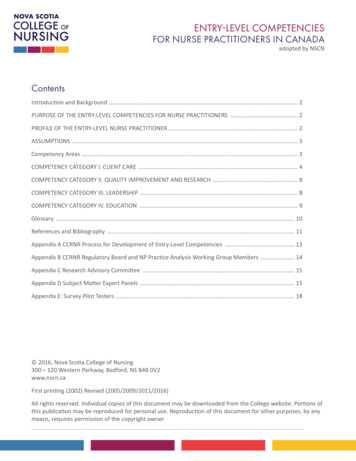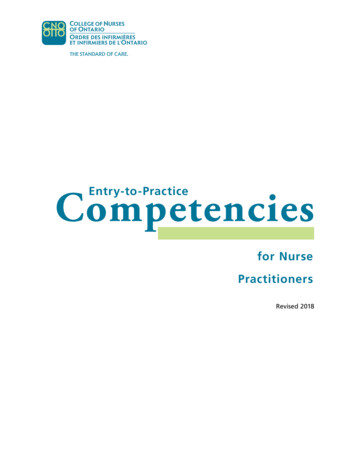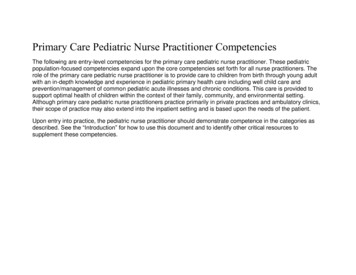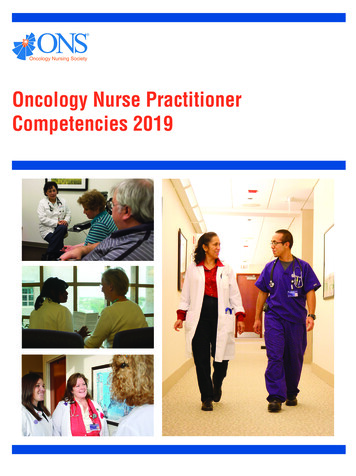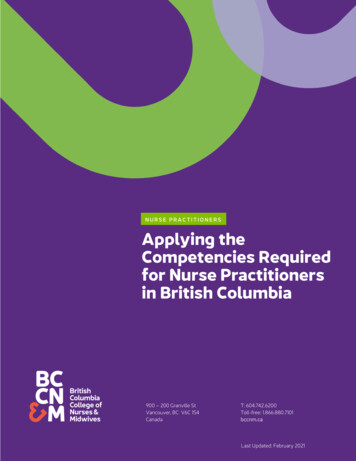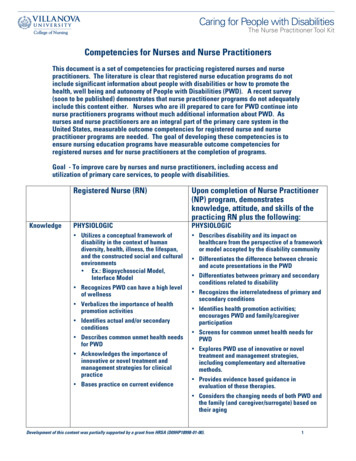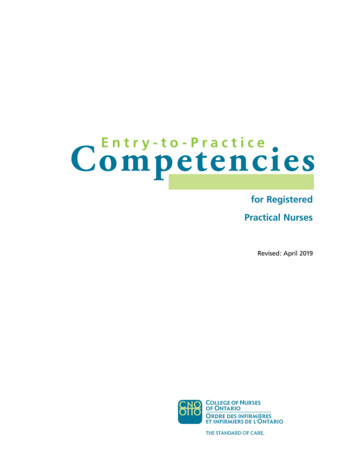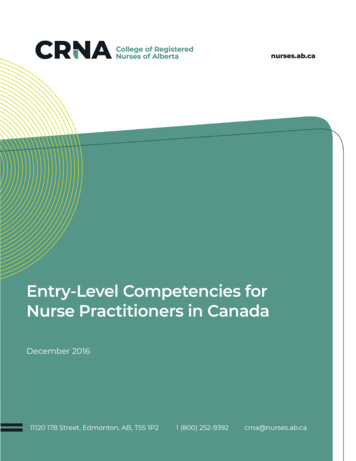
Transcription
Entry-Level Competencies forNurse Practitioners in CanadaDecember 2016
CompetenciesApproved by the College and Association of Registered Nurses of Alberta (CARNA) Council,December 2016.CARNA is operating as the College of Registered Nurses of Alberta (CRNA).Use of this document is permitted for the purposes of education, research, private study orreference.Ensure you are using the current version of this document by visiting our website.College of Registered Nurses of Alberta11120 – 178 StreetEdmonton, AB T5S 1P2Phone:Fax:Email:Website:1780.451.0043 (in Edmonton) or 1.800.252.9392 es.ab.ca
CompetenciesTable of ContentsINTRODUCTION AND BACKGROUND . 3PURPOSE OF THE ENTRY-LEVEL COMPETENCIES FOR NURSE PRACTITIONERS . 4PROFILE OF THE ENTRY-LEVEL NURSE PRACTITIONER . 4ASSUMPTIONS . 5ENTRY-LEVEL COMPETENCIES . 5COMPETENCY CATEGORY 1: CLIENT CARE . 6COMPETENCY CATEGORY 2: QUALITY IMPROVEMENT AND RESEARCH . 12COMPETENCY CATEGORY 3: LEADERSHIP. 13COMPETENCY CATEGORY 4: EDUCATION.14GLOSSARY . 15REFERENCES . 18RESOURCES . 19APPENDIX A: CCRNR PROCESS FOR DEVELOPMENT OF ENTRY-LEVEL COMPETENCIES . 21APPENDIX B: ACKNOWLEDGMENTS . 23NURSE PRACTITIONER PRACTICE ANALYSIS WORKING GROUP MEMBERS . 23RESEARCH ADVISORY COMMITTEE . 24SUBJECT MATTER EXPERT PANELS . 252
CompetenciesIntroduction and BackgroundThe ENTRY-LEVEL COMPETENCIES 1 for nurse practitioners reflect the knowledge, skills andjudgement required of nurse practitioners to provide safe, competent, ethical andcompassionate care. While specific roles and responsibilities may vary by context and CLIENTpopulation, this document outlines the essential COMPETENCIES that all nurse practitionersmust possess to be proficient when they begin practice.The entry-level competencies outlined in this document were developed as part of a nationalanalysis of three streams of nurse practitioner practice: Family/All Ages (Primary care), Adultand Child/Pediatric undertaken by the Canadian Council of Registered Nurse Regulators(CCRNR). The identified competencies were based on an extensive review of Canadianregulatory documents (e.g., provincial/ territorial competencies, STANDARDS , etc.), along withrelevant research evidence and were validated through the practice analysis survey. SeeAppendix A for the process used by CCRNR in the development of the nurse practitionerentry-level competencies.The CCRNR board established a national working group with representatives from allCanadian nursing regulatory bodies to coordinate all aspects of the practice analysis. Inaddition, a Research Advisory Committee and three Subject Matter Expert panels wereestablished to support the project. Finally, 27 nurse practitioners from the three streams ofpractice completed a pilot test of the practice analysis survey (Appendix B).The entry level competencies outlined in this document are the product of the NursePractitioner Practice Analysis carried out between February 2014 and May 2015, and reflectthe trends in nurse practitioner practice during that timeframe. Other factors have an impacton healthcare delivery, necessitating nurse practitioners to develop knowledge and skill toeffectively address these issues in their practice. Some of these factors include CULTURALSAFETY, the impact of power differentials in HEALTH service delivery with diverse populations,the increasing prevalence of concerns with mental health and addictions in Canada, and therecommendations of the Truth and Reconciliation Commission of Canada (2015).1Words or phrases in BOLD CAPITALS upon first mention are defined in the glossary.3
CompetenciesPurpose of the Entry-Level Competencies forNurse PractitionersEntry-level competencies are one of the sentinel documents used by regulatory bodies in theregulation of nurse practitioner practice for the purpose of:recognition and approval of nurse practitioner education programs,development and approval of nurse practitioner entry-level examinations,assessment of nurse practitioners’ ongoing continuing COMPETENCE , andproviding information to the public, nurse practitioner education programs, employersand other stakeholders on the regulatory expectations of nurse practitioner practice. Profile of the Entry-Level Nurse PractitionerNurse practitioners are registered nurses with additional experience and nursing educationat the Masters level, which enables them to autonomously diagnose, treat and manage acuteand chronic2 physical and mental illnesses. As advanced practice nurses, they use their indepth nursing and clinical knowledge to analyze, synthesize and apply evidence to makedecisions about their client’s healthcare. They apply theory and knowledge from nursing andother disciplines to provide a comprehensive range of essential health services grounded inprofessional, ethical and legal standards within a holistic model of care. Nurse practitionerswork collaboratively with their clients to establish measurable goals, and identify andADVOCATE to close gaps in health outcomes.The principles of primary health care are foundational to nurse practitioner practice. Theseprinciples include accessibility, public participation, HEALTH PROMOTION, use of appropriatetechnology and intersectoral COLLABORATION (World Health Organization, 1998). This lens ofprimary health care facilitates nurse practitioner practice with diverse client populations in avariety of contexts and practice settings including acute care, primary care, rehabilitativecare, curative and supportive care, and palliative/end-of-life care.In addition to their role in clinical care, nurse practitioners have the knowledge and skills toplay a broader role in the healthcare system. They provide leadership and collaborate withmultiple stakeholders to improve health outcomes at the individual client, community andpopulation health levels. Nurse practitioners understand the unique health needs of diversepopulations, and the values that impact their access to care.Entry-level nurse practitioners require time and support from employers, mentors and thehealthcare team to consolidate their knowledge, skills and judgment, develop theirindividual approach to care delivery and establish professional relationships. As they develop2In Quebec, initial diagnoses of chronic illnesses are made by physicians in primary care.4
Competenciesconfidence in their clinical nurse practitioner role, they integrate and further develop theirleadership, research and mentoring skills that are a critical part of nurse practitioner practice.AssumptionsThe nurse practitioner entry-level competencies are based on the following assumptions:1.Nurse practitioner practice is grounded in values, knowledge and theories of nursingpractice.2.Entry-level competencies form the foundation for all aspects of nurse practitionerpractice, and apply across diverse practice settings and client populations.3.Entry-level competencies build and expand upon the competencies required of aregistered nurse and address the knowledge, skills and abilities that are included inthe nurse practitioners’ legislated SCOPE OF PRACTICE .4.Nurse practitioners require graduate nursing education with a substantial clinicalcomponent.5.Collaborative relationships with other healthcare providers involve both independentand shared decision making. All parties are accountable in the practice relationship asdetermined by their scopes of practice, educational backgrounds and competencies.Entry-Level CompetenciesThe entry-level competencies are organized into four competency categories: client care,quality improvement and research, leadership and education. The first competency area,client care is further divided into six sub-competency categories, which reflects theimportance of the clinical dimension of the nurse practitioner professional role.1.Client Care:1.1 Client Relationship Building and Communication1.2 Assessment1.3 Diagnosis1.4 Management1.5 Collaboration, CONSULTATION and REFERRAL5
Competencies1.6 Health Promotion2.Quality Improvement and Research3.Leadership4.Education:4.1 Client, Community and Healthcare Team4.2 Continuing CompetenceCompetency Category 1: Client Care1.1Client Relationship Building and CommunicationThe competent, entry-level nurse practitioner uses appropriate communicationstrategies to create a safe and therapeutic environment for client care.a. Clearly articulate the role of the nurse practitioner when interacting with theclient.b. Use developmentally and culturally-appropriate communication techniques andtools.c. Create a safe environment for effective and trusting client interaction whereprivacy and confidentiality are maintained.d. Use relational strategies (e.g., open-ended questioning, fostering partnerships) toestablish therapeutic relationships.e. Provide culturally-safe care, integrating clients’ cultural beliefs and values in allclient interactions.f.Identify personal beliefs and values and provide unbiased care.g. Recognize moral or ethical dilemmas, and take appropriate action if necessary(e.g., consult with others, involve legal system).h. Document relevant aspects of client care in client record.6
Competencies1.2AssessmentThe competent, entry-level nurse practitioner integrates an evidence-informedknowledge base with advanced assessment skills to obtain the necessaryinformation to identify client diagnoses, strengths, and needs.a. Establish the reason for the client encounter:i. Review information relevant to the client encounter (e.g., referralinformation, information from other healthcare providers, triage notes) ifavailable.ii. Perform initial observational assessment of the client’s condition.iii. Ask pertinent questions to establish the context for client encounter andchief presenting issue.iv. Identify urgent, emergent, and life-threatening situations.v. Establish priorities of client encounter.b. Complete relevant health history appropriate to the client’s presentation:i. Collect health history such as symptoms, history of presenting issue, pastmedical and mental health history, family health history, pre-natal history,growth and development history, sexual history, allergies, prescription andOTC medications, and COMPLEMENTARY AND ALTERNATIVE THERAPIES .ii. Collect relevant information specific to the client’s psychosocial, behavioral,cultural, ethnic, spiritual, developmental life stage, and social DETERMINANTSOF HEALTH .iii. Determine the client’s potential risk profile or actual risk behaviors (e.g.,alcohol, illicit drugs and/or controlled substances, suicide or self-harm,abuse or neglect, falls, infections).iv. Assess client’s strengths and health promotion, illness prevention, or riskreduction needs.c. Perform assessment:i. Based on the client’s presenting condition and health history, identify levelof assessment (focused or comprehensive) required, and perform review ofrelevant systems.7
Competenciesii. Select relevant assessment tools and techniques to examine the client.iii. Perform a relevant physical examination based on assessment findingsand specific client characteristics (e.g., age, culture, developmental level,functional ability).iv. Assess mental health, cognitive status, and vulnerability using relevantassessment tools.v. Integrate laboratory and diagnostic results with history and physicalassessment findings.1.3DiagnosisThe competent, entry-level nurse practitioner is engaged in the diagnostic processand develops differential diagnoses through identification, analysis, andinterpretation of findings from a variety of sources.a. Determine differential diagnoses for acute, chronic, and life threateningconditions:i. Analyze and interpret multiple sources of data, including results ofdiagnostic and screening tests, health history, and physical examination.ii. Synthesize assessment findings with scientific knowledge, determinants ofhealth, knowledge of normal and abnormal states of health/illness, patientand population-level characteristics, and epidemiology and health risks.iii. Generate differential diagnoses.iv. Inform the client of the rationale for ordering diagnostic tests.v. Determine most likely diagnoses based on clinical reasoning and availableevidence.vi. Order and/or perform screening and diagnostic investigations using bestavailable evidence to support or rule out differential diagnoses.vii. Assume responsibility for follow-up of test results.viii. Interpret the results of screening and diagnostic investigations usingevidence-informed clinical reasoning.8
Competenciesix. Confirm most likely diagnoses 3.b. Explain assessment findings and communicate diagnosis to client:i. Explain results of clinical investigations to client.ii. Communicate diagnosis to client, including implications for short- andlong- term outcomes and prognosis.iii. Ascertain client understanding of information related to findings anddiagnoses.1.4ManagementThe competent, entry-level nurse practitioner, on the basis of assessment anddiagnosis, formulates the most appropriate plan of care for the client, implementingevidence-informed therapeutic interventions in partnership with the client tooptimize health.a. Initiate interventions for the purpose of stabilizing the client in, urgent, emergent,and life-threatening situations (e.g., establish and maintain airway, breathing andcirculation; suicidal ideation).b. Formulate plan of care based on diagnosis and EVIDENCE -INFORMED PRACTICE :i. Determine and discuss options for managing the client's diagnosis,incorporating client considerations (e.g., socioeconomic factors, geography,developmental stage).ii. Select appropriate interventions, synthesizing information includingdeterminants of health, evidence-informed practice and client preferences.iii. Initiate appropriate plan of care (e.g. non-pharmacological,pharmacological, diagnostic tests, referral).iv. Consider resource implications of therapeutic choices (e.g. cost,availability).c. Provide pharmacological interventions, treatment, or therapy:NPs have the authority to diagnose a client’s health conditions autonomously according totheir jurisdictional legislation/regulations.39
Competenciesi. Select pharmacotherapeutic options as indicated by diagnosis based ondeterminants of health, evidence-informed practice, and client preference.ii. Counsel client on pharmacotherapeutics, including rationale, cost,potential adverse effects, interactions, contraindications and precautions,as well as, reasons to adhere to the prescribed regimen and requiredmonitoring and follow-up.iii. Complete accurate prescription(s) in accordance with applicablejurisdictional and institutional requirements.iv. Establish a plan to monitor client’s responses to medication therapy andcontinue, adjust or discontinue a medication based on assessment of theclient’s response.v. Apply strategies to reduce risk of harm involving controlled substances,including medication abuse, addiction and diversion.d. Provide non-pharmacological interventions, treatments or therapies:i. Select therapeutic options (including complementary and alternativeapproaches) as indicated by diagnosis based on determinants of health,evidence-informed practice and client preference.ii. Counsel client on therapeutic option(s), including rationale, potential risksand benefits, adverse effects, required after care, and follow-up.iii. Order required treatments (e.g., wound care, phlebotomy).iv. Discuss and arrange follow-up.e. Perform invasive and non-invasive procedures:i. Inform client about the procedure, including rationale, potential risks andbenefits, adverse effects, and anticipated aftercare and follow-up.ii. Obtain and document informed consent from the client.iii. Perform procedures using evidence-informed techniques.iv. Review clinical findings, aftercare and follow-up.f.10Provide oversight of care across the continuum for clients with complex and/orchronic conditions.
Competenciesg. Follow up and provide ongoing management:i. Develop a systematic and timely process for monitoring client progress.ii. Evaluate response to plan of care in collaboration with the client.iii. Revise plan of care based on client’s response and preferences.1.5Collaboration, Consultation, and ReferralThe competent, entry-level nurse practitioner identifies when collaboration,consultation, and referral are necessary for safe, competent, and comprehensiveclient care.a. Establish collaborative relationships with healthcare providers and communitybased services (e.g., school, police, child protection services, rehabilitation, homecare).b. Provide recommendations or relevant treatment in response to consultationrequests or incoming referrals.c. Identify need for consultation and/or referral (e.g., to confirm a diagnosis, toaugment a plan of care, to assume care when a client’s health condition is beyondthe nurse practitioner’s individual competence or legal scope of practice).d. Initiate a consultation and/or referral, specifying relevant information (e.g., clienthistory, assessment findings, diagnosis) and expectations.e. Review consultation and/or referral recommendations with the client andintegrate into plan of care as appropriate.1.6Health PromotionThe competent, entry-level nurse practitioner uses evidence and collaborates withcommunity partners and other healthcare providers to optimize the health ofindividuals, families, communities, and populations.a. Identify individual, family, community and/or population strengths and healthneeds to collaboratively develop strategies to address issues.b. Analyze information from a variety of sources to determine population trends thathave health implications.c. Select and implement evidence-informed strategies for health promotion andprimary, secondary and tertiary prevention.11
Competenciesd. Evaluate outcomes of selected health promotion strategies and revise the planaccordingly.Competency Category 2: Quality Improvementand ResearchThe competent, entry-level nurse practitioner uses evidence-informed practice, seeks tooptimize client care and health service delivery, and participates in research.a. Identify, appraise, and apply research, practice guidelines, and current bestpractice.b. Identify the need for improvements in health service delivery.c. Analyze the implications (e.g., opportunity costs, unintended consequences) forthe client and/or the system of implementing changes in practice.d. Implement planned improvements in healthcare and delivery structures andprocesses.e. Participate in quality improvement and evaluation of client care outcomes andhealth service delivery.f.Identify and manage risks to individual, families, populations, and the healthcaresystem to support quality improvement.g. Report ADVERSE EVENTS to clients and/or appropriate authorities, in keeping withrelevant legislation and organizational policies.h. Analyze factors that contribute to the occurrence of adverse events and nearmisses and develop strategies to mitigate risks.12i.Participate in research.j.Contribute to the evaluation of the impact of nurse practitioner practice on clientoutcomes and healthcare delivery.
CompetenciesCompetency Category 3: LeadershipThe competent entry-level nurse practitioner demonstrates leadership by using the nursepractitioner role to improve client care and facilitate system change.a. Promote the benefits of the nurse practitioner role in client care to otherhealthcare providers and stakeholders (e.g., employers, social and public servicesectors, the public, legislators, policy-makers).b. Implement strategies to integrate and optimize the nurse practitioner role withinhealthcare teams and systems to improve client care.c. Coordinate interprofessional teams in the provision of client care.d. Create opportunities to learn with, from, and about other healthcare providers tooptimize client care.e. Contribute to team members' and other healthcare providers’ knowledge, clinicalskills, and client care (e.g., by responding to clinical questions, sharing evidence).f.Identify gaps and/or opportunities to improve processes and practices, andprovide evidence-informed recommendations for change.g. Utilize theories of and skill in communication, negotiation, conflict resolution,coalition building, and change management.h. Identify the need and advocate for policy development to enhance client care.i.13Participate in program planning and development to optimize client care.
CompetenciesCompetency Category 4: EducationThe competent, entry-level nurse practitioner integrates formal and informal education intopractice. This includes but is not limited to educating self, clients, the community, andmembers of the healthcare team.4.1Client, Community and Healthcare Team Educationa. Assess and prioritize learning needs of intended recipients.b. Apply relevant, theory-based, and evidence-informed content when providingeducation.c. Utilize applicable learning theories, develop education plans and selectappropriate delivery methods, considering available resources (e.g., human,material, financial).d. Disseminate knowledge using appropriate delivery methods (e.g., pamphlets,visual aids, presentations, publications).e. Recognize the need for and plan outcome measurements (e.g., obtaining clientfeedback, conduct pre- and post-surveys).4.2Continuing Competencea. Engage in self-reflection to determine continuing education competence needs.b. Engage in ongoing professional development.c. Seek mentorship opportunities to support one’s professional development.14
CompetenciesGlossaryADVANCED NURSING PRACTICE – An umbrella term describing an advanced level of clinicalnursing practice that maximizes the use of graduate educational preparation, in-depthnursing knowledge, and expertise in meeting the health needs of individuals, families,groups, communities and populations. It involves analyzing and synthesizing knowledge;understanding, interpreting and applying nursing theory and research; and developing andadvancing nursing knowledge and the profession as a whole (Canadian Nurses Association,2008).ADVERSE EVENTS – Event that results in unintended harm to the client and are related to thecare and/or service provided to the client, rather than the client’s underlying condition (CNA,2010).ADVOCATE – To actively support a right and good cause; to support others in speaking forthemselves; to speak on behalf of those who cannot speak for themselves (CNA, 2010).CLIENT – Individuals, families, groups, populations or entire communities who require nursingexpertise. The term “client” reflects the range of individuals and/or groups with whom nursesmay be interacting. In some settings, other terms may be used such as patient or resident. Ineducation, the client may also be a student; in administration, the client may also be anemployee; and in research, the client is usually a subject or participant (Nurses Association ofNew Brunswick, 2010).COLLABORATION – Client care involving joint communication and decision-making processesamong the client, nurse practitioner and other members of a health-care team who worktogether to use their individual and shared knowledge and skills to provide optimum clientcentred care. The health-care team works with clients toward the achievement of identifiedhealth outcomes, while respecting the unique qualities and abilities of each member of thegroup or team (CNA, 2010).COMPETENCE – The ability to integrate and apply the knowledge, skills, abilities and judgmentrequired to practise safely and ethically with a designated client population in a specificnurse practitioner role and practice setting (College of Registered Nurses of Nova Scotia,2011).COMPETENCIES – The specific knowledge, skills, abilities, and judgment required for a nursepractitioner to practise safely and ethically with a designated client population in a specificrole and practice setting (CRNNS, 2011).COMPLEMENTARY AND ALTERNATIVE THERAPIES – Health modalities or interventions that tend tobe used alongside conventional healthcare services, while alternative therapies tend to beused in place of conventional healthcare (College of Registered Nurses of British Columbia,2011).15
CompetenciesCONSULTATION – A request for another health professional’s advice on the care of a client. Thegoal is to enhance patient care and/or improve the skills and confidence of the professionalmaking the request (consultee). The consultant may or may not see the client directly. Theresponsibility for clinical outcomes remains with the consultee, who is free to accept or rejectthe advice of the consultant (CRNNS, 2011).CULTURAL SAFETY – Cultural safety is an outcome based on respectful engagement thatrecognizes and strives to address power imbalances inherent in the healthcare system. Itresults in an environment free of racism and discrimination, where people feel safe whenreceiving health care (First Nations Health Authority, 2015).DETERMINANTS OF HEALTH – The range of social, economic, geographic and systemic factorsthat influence a person’s health status and outcomes. These factors include: access toappropriate health services, biology, coping abilities, culture, education, employment andworking conditions, environment (natural and built, emotional and psychological), gender,genetics, health behaviours, income, lifestyle, and social status (CNA, 2010).ENTRY-LEVEL COMPETENCIES – The specific knowledge, skills, abilities, and judgment requiredfor a newly-graduated nurse practitioner to meet the minimum requirements for entry topractice (NANB, 2010).EVIDENCE-INFORMED PRACTICE – An approach to clinical practice that requires the nursepractitioner to conscientiously integrate critically appraised evidence with their experienceand knowledge of contextual factors to decide (in consultation with clients) what best suitsclients’ needs. Evidence may include, but is not limited to, published and unpublishedresearch, clinical practice guidelines, consensus statements, expert advice, and qualityassurance and patient safety data (CNA, 2010).HEALTH – A state of complete physical, mental, spiritual and social wellbeing, and not merelythe absence of disease (WHO, 1946).HEALTH PROMOTION – The process of enabling people to increase control over and improvetheir health. It embraces actions directed not only at strengthening the skills, confidence andcapabilities of individuals, but also at changing social, environmental, political and economicconditions to alleviate their impact on public and individual health (CNA, 2010).REFERRAL – An explicit request for another health professional to become involved in the careof a client. Accountability for clinical outcomes is negotiated between the health careprofessionals involved (CRNNS, 2011).16
CompetenciesSCOPE OF PRACTICE – The roles, functions, and accountabilities that nurse practitioners areeducated and authorized to perform, as established through legislated definitions of nursepractitioner practice, and complemented by standards, guidelines and policy positionsissued by nursing regulators (CRNA, 2011).STANDARDS – Authoritative statements that describe the required behavior of every nursepractitioner, and are used to evaluate individual performance. They provide a benchmarkbelow which performance is unacceptable (CNA, 2010).17
CompetenciesReferencesCanadian Nurses Association. (2008). Advanced nursing practice: A national framework.Ottawa, ON: Author.Canadian Nurses Association. (2010). Canadian nurse practitioner core competencyframework. Retrieved from http://cnaaiic.ca/ /media/cna/files/en/competency framework 2010 e.pdf.College and Association of Registered Nurses of Alberta. (2011). Scope of practice for nursepractitioners (NPs). Edmonton, AB: Author.College of Registered Nurses of Nova Scotia. (2011). Nurse practitioner competencyframework. Halifax, NS: Author.First Nations Health Authority. (2015). Cultura
The nurse practitioner entry-level competencies are based on the following assumptions: 1. Nurse practitioner practice is grounded in values, knowledge and theories of nursing practice. 2. Entry-level competencies form the foundation for all aspects of nurse practitioner

